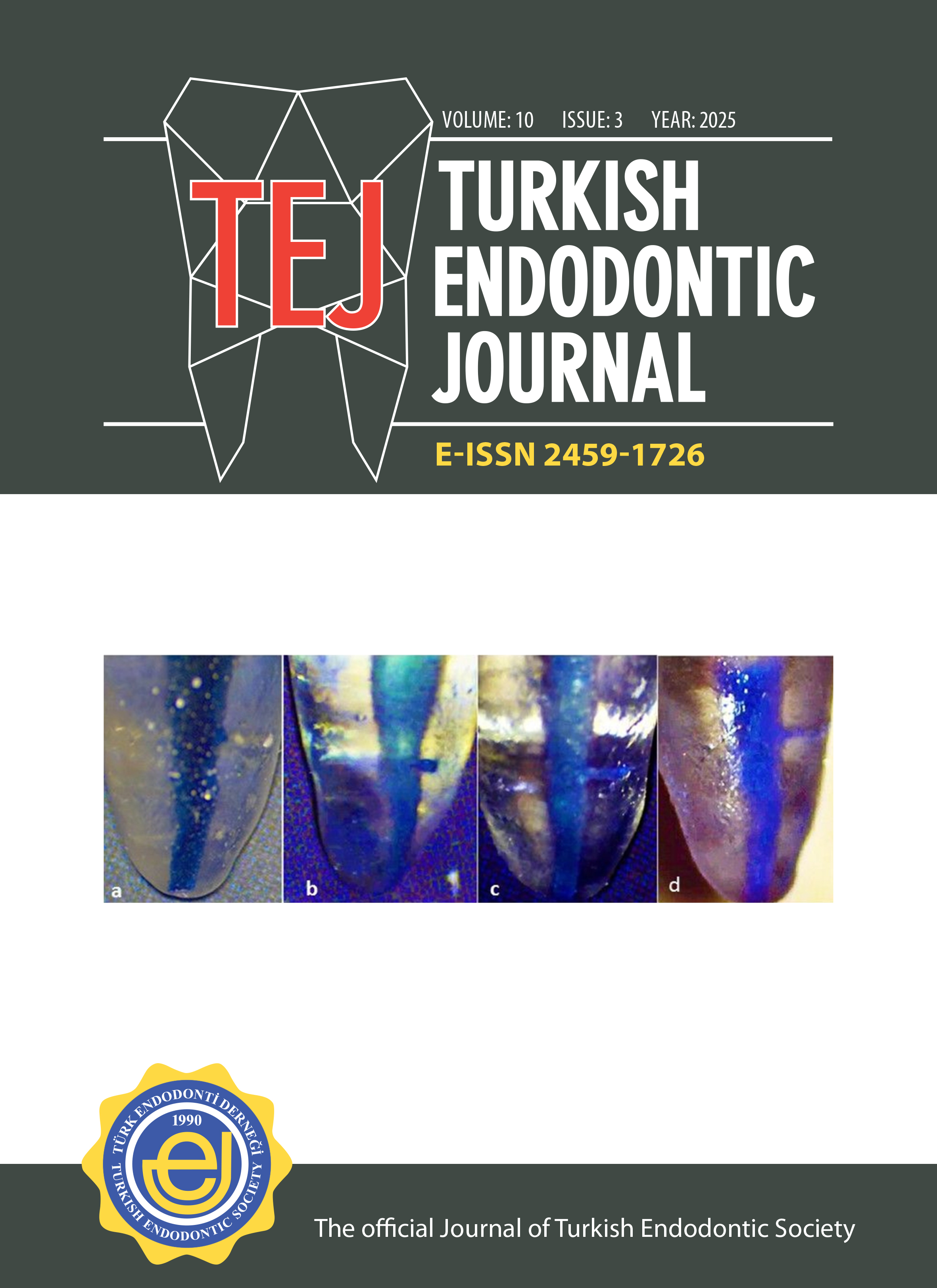Apical extrusion of intracanal biofilm after root canal preparation using Revo-S, Twisted File Adaptive, One Shape New Generation, ProTaper Next, and K3XF instrumentation systems
Recai Zan1, Huseyin Sinan Topcuoglu2, Tutku Tunc3, Senem Gokcen Yıgıt Ozer4, Ihsan Hubbezoglu5, Gizem Kutlu11Cumhuriyet University, Faculty Of Dentistry, Department Of Endodontics, Sivas, Turkey2Erciyes University, Faculty of Dentistry, Department of Endodontics, Kayseri, TURKEY
3Cumhuriyet University, Faculty of Medicine, Department of Microbiology, Sivas, TURKEY
4Adnan Menderes University, Faculty of Dentistry, Department of Endodontics, Aydın, TURKEY
5Cumhuriyet University, Faculty of Dentistry, Department of Restorative Dentistry, Sivas, TURKEY
Objective: To evaluate the amount of bacteria extruded apically during instrumentation using different nickel titanium (NiTi) rotary instruments.
Methods: Eighty extracted single-rooted human mandibular premolar teeth were inoculated with E. faecalis to obtain biofilm formation and the re-inoculation procedure was performed on the first, fourth, seventh and tenth days. The infected root canals were prepared using Revo-S (RS), Twisted File Adaptive (TFA), One Shape New Generation (OSNG), ProTaper Next (PTN), and K3XF instrumentation systems. The amount of apially extruded bacteria was incubated in brain heart infusion agar and it was measured in colony forming units per milliliter. Data were analyzed using the one-way analysis of variance (ANOVA) and Tukey post-hoc tests.
Results: The RS group caused more bacterial extrusion compared to other groups (p<0.05). Although the OSNG and K3XF caused the less amount of bacteria extrusion than TFA and PTN groups (p<0.05), there was no statistically significant difference between OSNG and K3XF (p>0.05). TFA extruded more bacteria compared to the PTN group (p<0.05).
Conclusion: All NiTi instrumentation systems were associated with apical extrusion of biofilm. OSNG and K3XF appear to be safer instruments in terms of biofilm extrusion compared to other instruments. The apically extruded bacteria may vary according to the instrument metallurgy, kinematics and design.
Keywords: Apical extrusion, biofilm, rotary files.
Revo-S, Twisted File Adaptive, OneShape New Generation, ProTaper Next ve K3XF Enstrümentasyon Sistemleri Kullanılarak Yapılan Kök Kanal Preparasyonu Sonrasında Apikalden Taşan Kanaliçi Biofilm
Recai Zan1, Huseyin Sinan Topcuoglu2, Tutku Tunc3, Senem Gokcen Yıgıt Ozer4, Ihsan Hubbezoglu5, Gizem Kutlu11Cumhuriyet Üniversitesi, Diş Hekimliği Fakültesi, Endodonti Anabilim Dalı, Sivas, Türkiye2Erciyes Üniversitesi, Diş Hekimliği Fakültesi, Endodonti Anabilim Dalı, Kayseri, Türkiye
3Cumhuriyet Üniversitesi, Tıp Fakültesi, Mikrobiyoloji Anabilim Dalı, Sivas, Türkiye
4Adnan Menderes Üniversitesi, Diş Hekimliği Fakültesi, Endodonti Anabilim Dalı, Aydın, Türkiye
5Cumhuriyet Üniversitesi, Diş Hekimliği Fakültesi, Restoratif Diş Hekimliği Anabilim Dalı, Sivas, Türkiye
Amaç: Bu çalışmanın amacı, farklı nikel titanyum döner eğeleri kullanılararak yapılan enstrümantasyon sırasında apikalden taşan bakteri miktarını değerlendirmektir.
Gereç ve Yöntem: Seksen insan tek köklü mandibular premolar diş biyofilm oluşumunu elde etmek için Enterococcus faecalis ile inoküle edildi ve inokülasyon prosedürü, Birinci dördüncü, yedinci ve onuncu günlerinde yeniden gerçekleştirildi. Enfekte kök kanalları Revo-S(RS), Twisted File Adaptive(TFA), One Shape New Generation(OSNG), ProTaper Next(PTN), ve K3XF enstrümantasyon sistemleri ile prepare edildi. Apikal foramen dışına taşan bakteri enstrümantasyondan sonra beyin kalp infüzyon agar’a inkübe edildi ve mililitre başına koloni oluşturan birimler ölçüldü. Veriler istatistiksel olarak tek yönlü varyans analizi (ANOVA) ve Tukey testi kullanılarak analiz edilmiştir.
Çıkarım: RS grubu diğer tüm gruplara kıyasla daha fazla bakteri ekstrüzyonuna neden oldu (P<0,05). OSNG ve K3XF grupları TFA and PTN gruplarına göre daha az bakteri ekstrüzyonuna neden olmasına rağmen (P<0,05), OSNG ve K3XF grupları arasında istatistiksel olarak anlamlı bir fark yoktu (P>0,05). TFA grubu PTN grubuna kıyasla daha fazla bakteri taşırmıştır.
Sonuç: Tüm NiTi enstrümantasyon sistemleri apikal ekstrüzyonu ile ilişkili bulunmuştur. OSNG and K3XF bakteriyel ekstrüzyon açısından test edilen diğer enstrümanlar ile karşılaştırıldığında daha güvenli tercih edilebilir sistemlerdir. Apikalden taşan bakteri miktarı, kullanılan enstrümanın metalürjisine, kinematiğine ve tasarımına göre değişebilir.
Anahtar Kelimeler: Apikal ekstrüzyon, döner aletler, biofilm.
Manuscript Language: English



















